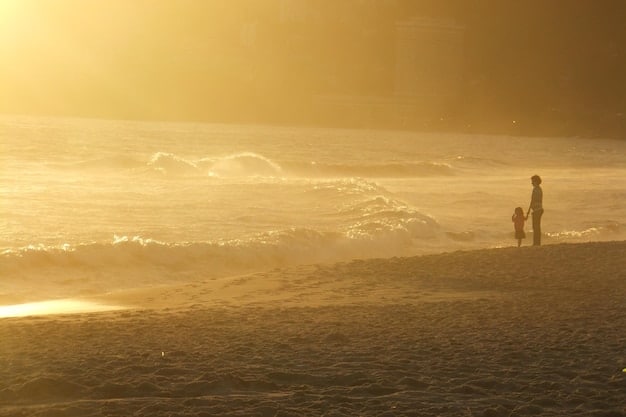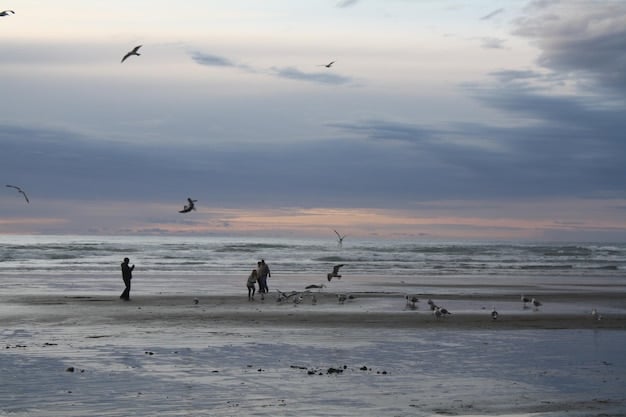Unlock 25% Savings: Off-Season Beach Vacations in the US

Exploring off-season beach vacations in the US offers significant savings, fewer crowds, and unique experiences from coastal towns to popular seaside destinations, enabling budget-savvy travelers to enjoy coastal beauty without the peak season price tag.
Are you dreaming of sandy toes and ocean breezes but cringe at peak-season prices and crowds? Look no further than Unlock 25% Savings: The Ultimate Guide to Off-Season Beach Vacations in the US. This comprehensive guide will reveal how smart timing can transform your coastal escape into an affordable, peaceful, and truly memorable experience, far from the summer rush.
The Allure of Off-Season: Beyond Just Savings
The concept of an off-season vacation often conjures images of uninviting weather or closed attractions. However, the reality for US beach destinations is far more appealing. Beyond the undeniable financial benefits, traveling during the shoulder or off-peak months offers a vastly different, often superior, experience. It’s about trading the bustling boardwalks and crowded beaches for tranquility and genuine local charm. This strategic shift in travel dates can redefine what a beach vacation feels like, prioritizing peace and authentic discovery over the usual summer scramble.
Maximizing Your Dollar: The Financial Edge
The most apparent advantage of off-season travel is the significant cost reduction. Accommodations, from luxury resorts to quaint beachside rentals, often drop their rates by 25% or more, and sometimes even up to 50%, once the summer crowds dissipate. Airfares, car rentals, and even local dining can become considerably cheaper, making a once-out-of-reach destination suddenly accessible. These savings aren’t just limited to the big-ticket items; consider the cumulative effect on your overall travel budget.
- Lodging Discounts: Expect substantial cuts in hotel and rental property rates.
- Cheaper Flights: Airlines often reduce fares in response to lower demand.
- Reduced Rental Car Costs: Fewer tourists mean better deals on car rentals.
- Dining Deals: Many local restaurants offer specials to attract off-season visitors.
The financial relief extends opportunities that might otherwise be unaffordable. Perhaps you can upgrade your lodging, stay an extra night, or allocate more of your budget to unique local experiences, turning a standard trip into something truly special. It’s an intelligent way to experience premium destinations without paying premium prices. This economic flexibility means you can tailor your trip to your desires, rather than being dictated by cost constraints.
Beyond the direct monetary benefits, the off-season allows for a level of spontaneity often impossible during peak times. Last-minute bookings become less risky, and the pressure to plan every detail months in advance diminishes. This flexibility contributes to a more relaxed and enjoyable travel experience, aligning perfectly with the laid-back vibe of a beach getaway. Ultimately, the cost savings are a gateway to richer, more personalized travel.
Embrace the Calm: Fewer Crowds, More Serenity
One of the most compelling, yet often overlooked, benefits of off-season beach travel is the drastic reduction in crowds. Imagine wide-open beaches where the only footprints are yours, instead of struggling to find a patch of sand amidst a sea of umbrellas. Picture leisurely strolls through charming coastal towns, interacting with locals instead of being swept along with tourist hordes. This shift from crowded chaos to serene solitude fundamentally changes the vacation experience.
Experience Authentic Local Life
When the tourist season wanes, the true character of a beach town emerges. Local businesses, no longer overwhelmed by the summer rush, have more time and inclination to engage with visitors. This often translates into more personalized service, genuine interactions, and opportunities to discover hidden gems that cater to the local community, not just tourists. You might find yourself striking up a conversation with a shop owner, receiving insider tips on the best places to eat, or stumbling upon a local festival that celebrates the area’s unique heritage. This deeper immersion into the local culture is invaluable.
- Personalized Service: Shop owners and restaurant staff can offer more individual attention.
- Hidden Gems: Discover local spots away from the main tourist drag.
- Genuine Interactions: Engage with residents on a more personal level.
- Local Events: Experience community-focused events and traditions.
The quiet atmosphere also fosters a sense of introspection and relaxation. Without the constant buzz of crowds, the natural beauty of the coastline takes center stage. The sound of the waves becomes more prominent, the sunsets more vivid, and the crisp, clean air more invigorating. It’s an opportunity to truly disconnect, recharge, and appreciate the simple pleasures of a beachfront escape. The absence of long lines and packed venues reduces stress, allowing for a more fluid and enjoyable itinerary.
Moreover, popular attractions, from lighthouses to aquariums, become more accessible. You can explore at your own pace, linger over exhibits, and capture photographs without battling for space. This enhanced accessibility makes for a more fulfilling and less hurried exploration of the area’s offerings. The off-season transforms a hurried checklist into a leisurely journey of discovery, making every moment more impactful.

Top Off-Season Beach Destinations in the US
Choosing the right destination for an off-season beach vacation involves considering factors like climate, specific local attractions, and the typical shoulder seasons. While summer is universally peak, the ideal off-season can vary significantly across the US coastline. Generally, autumn and spring offer the best weather compromise, providing pleasant temperatures without the summer heat or humidity, and extending the period of reduced crowds and prices.
Southeast Coast: Florida and the Carolinas
The Southeast offers a fantastic range of options for off-season beach trips, largely due to its milder winter climate. Florida, in particular, offers year-round opportunities. While late fall and winter might be cooler, they are still significantly warmer than much of the US and come with the added benefit of lower humidity and fewer insects. Destinations like the Florida Keys, South Beach in Miami, or the serene Gulf Coast beaches of Sanibel and Captiva can be enjoyed without the crushing crowds and peak prices.
The Carolinas, including the Outer Banks of North Carolina and the barrier islands of South Carolina like Kiawah and Hilton Head, shine in the shoulder seasons of spring and fall. September and October often bring warm ocean temperatures perfect for swimming, coupled with cooler evenings ideal for exploring. March and April provide a pleasant escape from winter, with blooming flora and warming waters. These months offer a perfect balance of good weather and fewer visitors.
Northeast Coast: New England Gems
Don’t write off the Northeast for off-season beach escapes. While winters are definitely cold, the late spring and early fall can be spectacular, especially for those seeking scenic beauty and charming coastal towns rather than dedicated swimming. The Outer Cape in Massachusetts (think Provincetown and Wellfleet) or the rocky shores of Maine (like Kennebunkport) transform into picturesque havens.
- Cape Cod and Islands (MA): September and October offer beautiful foliage, pleasant walking weather, and quieter towns.
- Maine Coast: Spring and early fall are stunning for hiking, exploring lighthouses, and enjoying fresh seafood without the summer rush.
- Rhode Island: Newport and Narragansett are charming in the shoulder seasons, offering historic sights and picturesque scenery.
The autumn months, in particular, bring crisp air, vibrant fall foliage contrasting with the ocean blue, and a peaceful ambiance perfect for leisurely strolls, antique shopping, and enjoying fresh seafood without the clamor. Many shops and restaurants remain open, catering to a smaller, more appreciative clientele.
West Coast: California’s Diverse Shores
California’s extensive coastline offers diverse off-season possibilities. Southern California beaches, from San Diego to Santa Barbara, enjoy relatively mild weather year-round. While winter might bring occasional rain, many days are sunny and pleasant, perfect for beach walks or surfing. The crowds significantly thin out, making popular spots like Santa Monica Pier or Laguna Beach far more enjoyable.
Further north, destinations like Big Sur or Mendocino offer breathtaking scenery that is perhaps even more dramatic during the wilder, often misty, off-season months. Whale watching seasons often peak in winter and early spring along the California coast, providing a unique wildlife experience. The Pacific Northwest, while rainier in winter, offers dramatic storm-watching opportunities and rugged, uncrowded beaches for those who appreciate natural power and solitude.
Planning Your Off-Season Escape: Essential Tips
A successful off-season beach vacation requires a slightly different approach than a peak-season trip. While spontaneity is a benefit, some strategic planning maximizes your savings and ensures a smooth, enjoyable experience. This involves careful research into weather patterns, local business hours, and special events that might impact your visit.
Researching Weather and Local Holidays
The “off-season” is a broad term, and weather patterns can vary wildly. A beach in Florida in January will have vastly different conditions than one in Maine. Use reliable weather resources to understand average temperatures, rainfall, and wind conditions for your specific destination during your intended travel dates. For instance, while Florida’s Atlantic Coast is warm in winter, the Gulf Coast might be slightly cooler.
- Check Average Temperatures: Understand daily highs and lows.
- Rainfall Patterns: Be aware of typical precipitation for the month.
- Wind Conditions: Important for comfort, especially on exposed coastlines.
- Local Holiday Calendars: Avoid unexpected surges in crowds and prices due to local school breaks or festivals.
Equally important is checking for local holidays, school breaks, or community events. While you’re avoiding major national holidays, smaller local events can still draw crowds and impact pricing or availability. A little research goes a long way in ensuring your tranquil escape isn’t unexpectedly disrupted by a small town’s annual seafood festival or a college spring break week, if that’s not what you’re seeking. Look for online community calendars or local tourism board websites, which are excellent resources.
Accommodation and Activity Bookings
While off-season travel offers more flexibility for last-minute bookings, it’s still wise to book your primary accommodation in advance, especially if you have specific preferences (e.g., beachfront view, pet-friendly). Many smaller establishments might close for a few weeks in the deepest off-season, so confirm their operating hours.
For activities, verify their availability. Water sports rentals, tour operators, and even some restaurants might operate on reduced schedules or close entirely during the quietest months. A quick check of their websites or a phone call can save you disappointment upon arrival. However, some attractions like national parks or state beaches often remain open year-round, sometimes even with reduced entrance fees, offering fantastic opportunities for exploration. Many places cater specifically to the slower pace, offering unique off-season programs.

Activities and Experiences Unique to the Off-Season
Beyond the obvious benefits of reduced costs and fewer crowds, the off-season opens up a unique array of activities and experiences that are often overshadowed or impossible during peak tourist times. This period encourages a slower pace, deeper engagement with natural surroundings, and opportunities for cultural immersion that are simply not available when the beaches are packed.
Nature’s Grandeur: Wildlife and Scenery
The off-season reveals the natural world in a raw, often more dramatic state. Migratory birds often pass through coastal areas in fall and spring, making it a prime time for birdwatching. Whale watching seasons typically occur in cooler months, offering thrilling encounters with marine giants. The absence of human activity allows for more intimate wildlife sightings and a sense of being truly connected to nature.
Coastal landscapes also take on a different character. Stormy seas deliver powerful waves, creating impressive spectacles for storm watchers. Crisp air enhances visibility, making sunrises and sunsets even more vibrant. Many state and national parks along the coast become ideal for hiking and exploring without the oppressive heat or bustling trails of summer. This is an opportunity to appreciate the rugged beauty of the coast in a way that peak season simply can’t offer.
A Different Kind of Beach Day
While swimming might be less appealing in cooler temperatures, the beach remains a magical place. Long, uninterrupted walks collecting shells or sea glass become meditative experiences. Photography enthusiasts will find endless inspiration in the softer light, dramatic skies, and unblemished landscapes. Even simply bundling up with a warm drink and watching the waves can be profoundly relaxing. This is restorative time, not just recreational.
- Beachcombing: Prime time for finding unique shells and sea glass.
- Photography: Capture stunning landscapes with ideal lighting and fewer distractions.
- Storm Watching: Witness the powerful beauty of the ocean during cooler months.
- Bonfires (where permitted): Enjoy cozy evenings under the stars.
Many beach towns also embrace the off-season with unique events. Holiday markets, local food festivals (think oyster roasts in the fall), and art walks are common during these quieter periods, offering a taste of local culture that’s distinct from the summer festivities. These events often cater more to the local community, providing an authentic glimpse into the area’s traditions and passions.
Ultimately, the off-season redefines the beach vacation. It moves beyond just swimming and sunbathing to encompass a broader spectrum of experiences – from quiet contemplation and wildlife observation to cultural discovery and invigorating outdoor pursuits. It’s about embracing the ever-changing face of the coast and finding beauty in every season, truly maximizing your appreciation for these unique environments.
Budgeting Beyond the Savings: Smart Spending Strategies
While off-season travel inherently offers significant savings, combining this with smart budgeting strategies can maximize your financial benefits. It’s about being an astute traveler, making calculated choices that amplify your dollar without compromising the quality of your experience. This layered approach to saving ensures your trip is not only affordable but also provides excellent value.
Accommodations: Beyond Hotels
Consider alternatives to traditional hotels. Vacation rentals, especially for longer stays, can offer substantial discounts and the added benefit of a kitchen, allowing for self-catering. Look for properties with amenities like fireplaces or hot tubs that enhance a cooler-weather beach experience. Off-season is also an excellent time for boutique inns and bed and breakfasts that might be fully booked or pricey during peak season. Their owners often have valuable local insights.
If you’re flexible with your exact dates, use booking websites with flexible date search features to compare prices across a range of days or weeks. Sometimes shifting your trip by just a few days can unlock significantly better rates. Also, consider booking directly with property owners or smaller hotels, as they may offer loyalty discounts or better rates than large booking platforms during the slower season.
Food and Drink: Eat Like a Local
Eating out is often a significant portion of any travel budget. In the off-season, many restaurants offer “locals’ specials” or early bird menus to attract diners. Ask around, check local newspaper listings, or browse community social media groups for these deals. Prioritize farmers’ markets for fresh produce and local ingredients, allowing you to prepare some meals at your accommodation. This not only saves money but also offers a taste of the region’s culinary delights.
- Utilize Kitchens: Cook some meals at your rental to save on dining costs.
- Look for Specials: Inquire about local discounts or early bird deals at restaurants.
- Visit Farmers’ Markets: Buy fresh, local produce and unique goods.
- Happy Hour Deals: Take advantage of reduced prices on drinks and appetizers.
Beyond the cost, dining in the off-season often means a better, more relaxed experience at restaurants. Chefs and staff are less rushed, leading to better service and potentially more elaborate preparations. It’s an opportunity to truly savor the local cuisine without feeling hurried. Don’t be afraid to ask locals for their favorite casual dining spots; these hidden gems often provide the best value and most authentic taste.
Sustainability and Local Impact in the Off-Season
Traveling during the off-season extends benefits beyond your personal wallet and experience; it also has a positive impact on the environment and the local economy. Supporting destinations when they are less busy contributes to a more sustainable tourism model, helping to alleviate overtourism and providing consistent income for local communities.
Reducing Environmental Strain
Peak season often places immense strain on a destination’s infrastructure and natural resources. Beaches become more eroded, waste generation increases, and carbon footprints soar due to higher volumes of air and road travel. By choosing the off-season, you’re contributing to a more even distribution of tourism’s environmental impact.
Fewer people mean less demand on water and energy resources, reduced litter on beaches and trails, and less disruption to local wildlife. It’s a quieter, gentler form of tourism that allows nature to recover and thrive. For environmentally conscious travelers, this aspect of off-season travel can be as appealing as the financial savings, aligning personal values with travel choices.
Boosting Local Economies
Many coastal communities rely heavily on tourism, but an over-reliance on a short peak season can lead to economic instability, with significant layoffs and closures during the rest of the year. Off-season visitors provide a crucial lifeline, offering year-round employment opportunities and supporting local businesses during quieter months.
- Steady Employment: Helps local workers maintain jobs outside of peak season.
- Support Local Businesses: Provides revenue during slower periods, preventing closures.
- Community Resilience: Fosters a more stable and sustainable local economy.
- Diversified Offerings: Encourages businesses to innovate and cater to different visitor types.
Your off-season spending, whether it’s on a quiet meal at a family-run restaurant, a purchase at a local artisan shop, or a booking at a quaint bed and breakfast, directly contributes to the livelihoods of residents. It helps keep the unique character of these towns alive, preventing them from becoming solely seasonal resorts. This symbiotic relationship between off-season travelers and local communities fosters a more authentic and enriching experience for everyone involved, making your travel dollars truly impactful.
Moreover, the off-season often allows for a more direct engagement with local initiatives, such as conservation efforts or community projects. You might even find opportunities to volunteer or participate in events that support the local environment or culture, further deepening your connection to the place you visit. This responsible travel approach ensures that the destinations you love can continue to thrive for future generations.
| Key Benefit | Brief Description |
|---|---|
| 💰 Cost Savings | Significant discounts on lodging, flights, and activities, often 25% or more. |
| 🧘♀️ Fewer Crowds | Enjoy peaceful beaches, easier access to attractions, and genuine local interactions. |
| ✨ Unique Experiences | Witness wildlife migrations, dramatic scenery, and authentic local events. |
| 🌿 Sustainable Travel | Reduces environmental strain and provides crucial year-round support to local economies. |
Frequently Asked Questions
▼
The best months depend on the region. For the Southeast (Florida, Carolinas), late fall (October-November) and early spring (March-April) offer pleasant weather. In the Northeast (New England), late spring (May-early June) and early fall (September-October) are ideal. California’s southern coast is good almost year-round, while Northern California and the Pacific Northwest are best in late spring/early fall for milder weather, though winters offer dramatic scenery.
▼
You can typically save 25% to 50% on accommodation costs during the off-season. Flights and car rentals can also see significant price drops due to reduced demand. The overall savings on a whole trip can be substantial, allowing you to either spend less or allocate more budget to experiences, dining, or extending your stay. It truly makes premium destinations more accessible on a budget.
▼
While many popular attractions remain open, some might operate on reduced hours or close entirely for a few weeks, especially in the deepest part of the off-season. Smaller, seasonal businesses may also be closed. It’s always best to check individual websites or call ahead for specific operating hours of places you plan to visit, ensuring you’re not disappointed upon arrival.
▼
Even if it’s too cool for swimming, off-season beaches offer numerous activities. These include long, peaceful beach walks, shell collecting, photography, fishing, birdwatching (especially during migrations), and exploring charming coastal towns without crowds. Many destinations also feature hiking trails, historical sites, and local events like fall festivals or holiday markets that are unique to the cooler seasons.
▼
Yes, off-season travel is generally more environmentally friendly. It helps distribute the impact of tourism more evenly throughout the year, reducing strain on natural resources and infrastructure during peak times. Fewer crowds mean less waste, less congestion, and often less disruption to local ecosystems. Additionally, supporting local businesses in their slower months helps foster a more sustainable and resilient local economy, benefiting the community in the long run.
Conclusion
Embracing the off-season for your beach vacation in the US is a strategic move that delivers far more than just financial savings. It’s an invitation to experience coastal destinations with unparalleled tranquility, authentic local charm, and a deeper connection to nature. By shedding the peak-season pressures, you unlock opportunities for relaxation, discovery, and a truly memorable escape. From the gentle breezes of Florida’s autumn beaches to the dramatic skies of a New England spring, the off-season offers a rich tapestry of experiences awaiting the discerning traveler. Plan wisely, set your sights on quieter shores, and prepare to redefine your idea of the perfect beach getaway.





